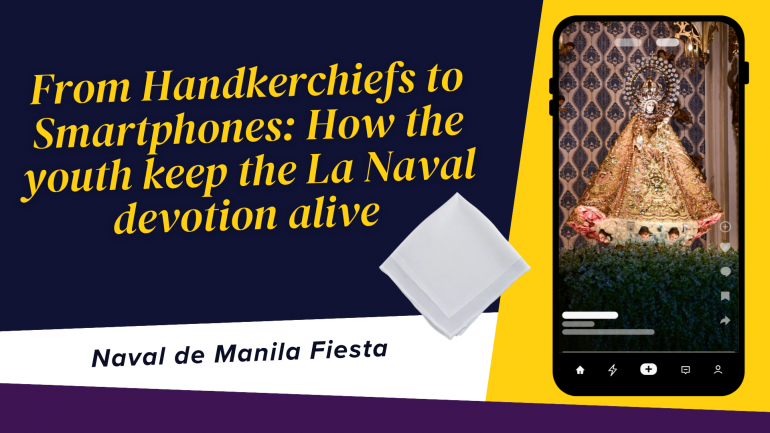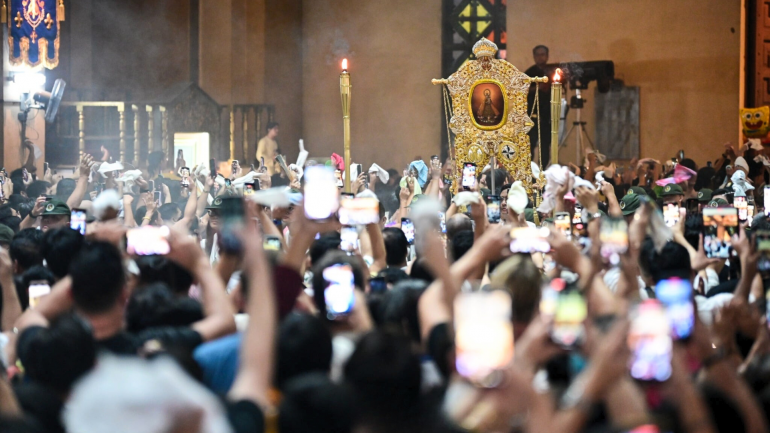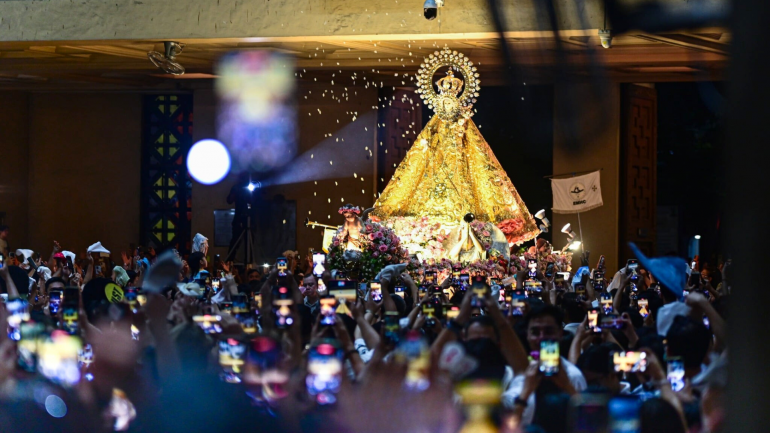From Handkerchiefs to Smartphones: How the youth keep the La Naval devotion alive

The waving of white handkerchiefs may no longer dominate the grand celebration of La Naval de Manila fiesta in the Philippines, but the devotion continues to glow; this time through the light of smartphones raised high.
For many young devotees, capturing a photo or video is not a mere spectacle; it has become a digital expression of faith, a modern way of saying, “Mary, we are here.”
Each year, thousands of devotees from different parts of the Philippines flock to the National Shrine of Our Lady of the Rosary of La Naval de Manila, in Sto. Domingo Church, Quezon City, is drawn not only by tradition but by an enduring love for the Blessed Mother. This devotion, born in the 17th century after the miraculous victory in the Battle of La Naval, remains one of the most cherished symbols of Filipino faith. Yet today, it finds new life in the hands and screens of a younger generation.
“La Naval de Manila, aside from being a treasured historical image, is also a heritage of faith that bears witness to stories of miracles and devotion throughout history,” shared Fray Jhim Sambrano, OP, a first-year theology student. “Especially in our present situation marked by consecutive calamities and corruption, La Naval invites us to become bearers of hope to one another despite the difficulties,” he added.
A Devotion That Builds Community
For Fray Jhim, the endurance of the La Naval devotion lies not only in its grandeur or rituals, but in the sense of belongingness it nurtures, especially among the young. The Dominican community, he explained, sees it as their mission to keep that sense of community alive both offline and online.
“There should be a sense of belongingness and community among our devotees, especially the younger generation,” Fray Jhim said. “That is why we are establishing connections within the Basic Ecclesial Communities and strengthening our social media presence to introduce and reintroduce this devotion on virtual platforms. Through this, we hope to invite them to participate in our celebrations and accompany them in nurturing their Christian life.”
These efforts mirror how the faith community continues to evolve with time, embracing modern tools while holding firmly to tradition. The Dominican friars’ engagement on social media is more than publicity; it is a digital form of evangelization, meeting young people where they are and drawing them into deeper encounter.

From White Handkerchiefs to Raised Phones
In the past, the sight of waving handkerchiefs, especially during the re-enthronement of the image of La Naval, symbolized heartfelt praise and gratitude to Mary. Today, smartphones have taken their place, an image that may seem detached, yet, as Fray Jhim notes, also carries meaning.
“Perhaps this new expression reveals our desire for remembrance, a kind of pag-alaala (‘to remember’), that we wish to share with others through social media,” he reflected. “However, I hope that our devotion does not remain a mere outward display but grows into a deep internalization of what we celebrate, moving from the external to the internal.”
Indeed, every photo taken and every video shared is more than just a keepsake; it becomes the devotees’ way of bringing home the grace of the celebration. They capture these moments because they want to remember that they were present, part of something sacred and beautiful. In sharing photos and videos, they hope that others, too, may be touched and blessed. Each image becomes a memory treasured in their hearts, a reminder of how blessed they are to have witnessed such faith and joy.

The Rosary: A Call to Mission
The same spirit of renewal echoed in the homily of Most Rev. Elias L. Ayuban, Jr., CMF, DD, Bishop of Cubao, who reminded the faithful that Marian devotion is not simply part of Filipino culture; it is at the heart of who we are as a people.
“Devotion to the Blessed Virgin Mary is not just a part of our Filipino identity but woven into our very identity as a people,” the bishop said. He urged the faithful to revive the tradition of praying the rosary, describing it as a “powerful weapon against evil” and “a faithful companion in our nation’s struggles.” For Bishop Ayuban, praying the rosary is never an escape from reality but a preparation for mission.
“When we pray the rosary, we do not simply recite prayers; we meditate on the great mysteries of our salvation,” he explained. “The rosary, therefore, is not an escape from the world; it is a preparation for mission.” The prelate reminded the faithful that after praying, everyone is called to live what they have prayed, “to bring light where there is darkness, hope where there is despair, and truth where there is misinformation and falsehood.”
Faith that Adapts, Devotion that Endures
Through the blending of the traditional and the digital age, the devotion to Our Lady of the Most Holy Rosary, La Naval de Manila, continues to evolve yet remains steadfast. From the waving of white handkerchiefs to the glow of smartphone lights, what endures is the same heartfelt faith of a people who find comfort, courage, and hope in their mother.
As Bishop Ayuban beautifully said, to pray the rosary is to “invite Jesus and Mary into the story of our nation.” And as long as young Filipinos continue to raise their hands, whether in prayer or in capturing a sacred moment, Our Lady’s message of faith, hope, and love will keep shining brightly through the generations.
(Leahna Villajos, currently serving as the Social Media Officer at the Roman Catholic Diocese of Cubao, Philippines, is also a freelancer who contributes regularly to RVA and other Catholic platforms.)








